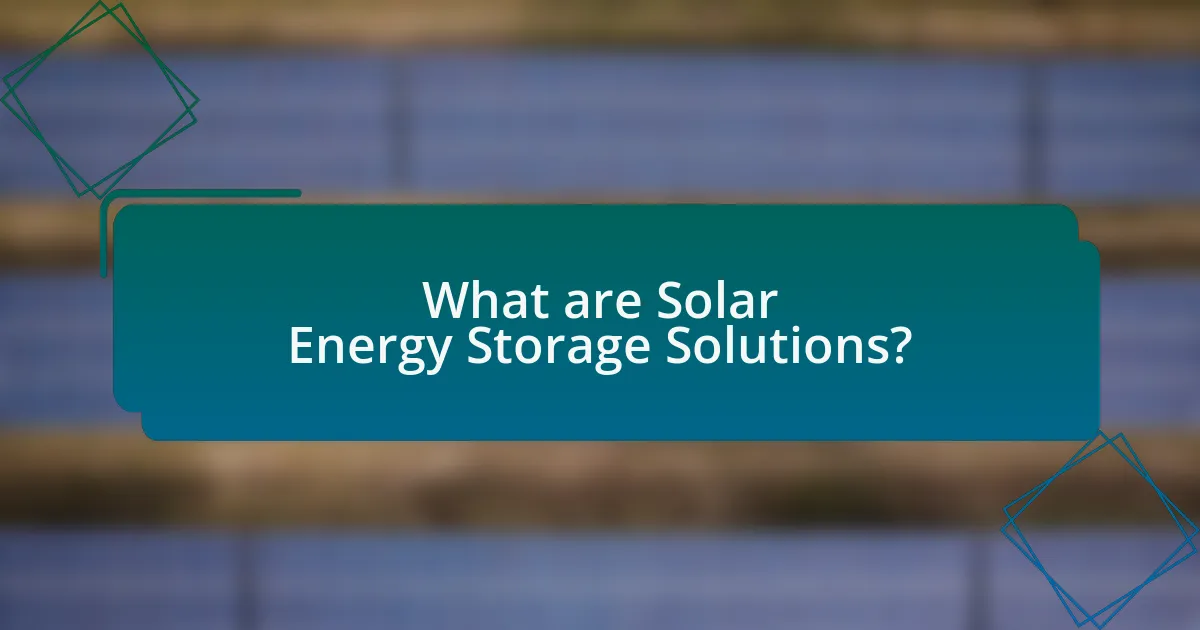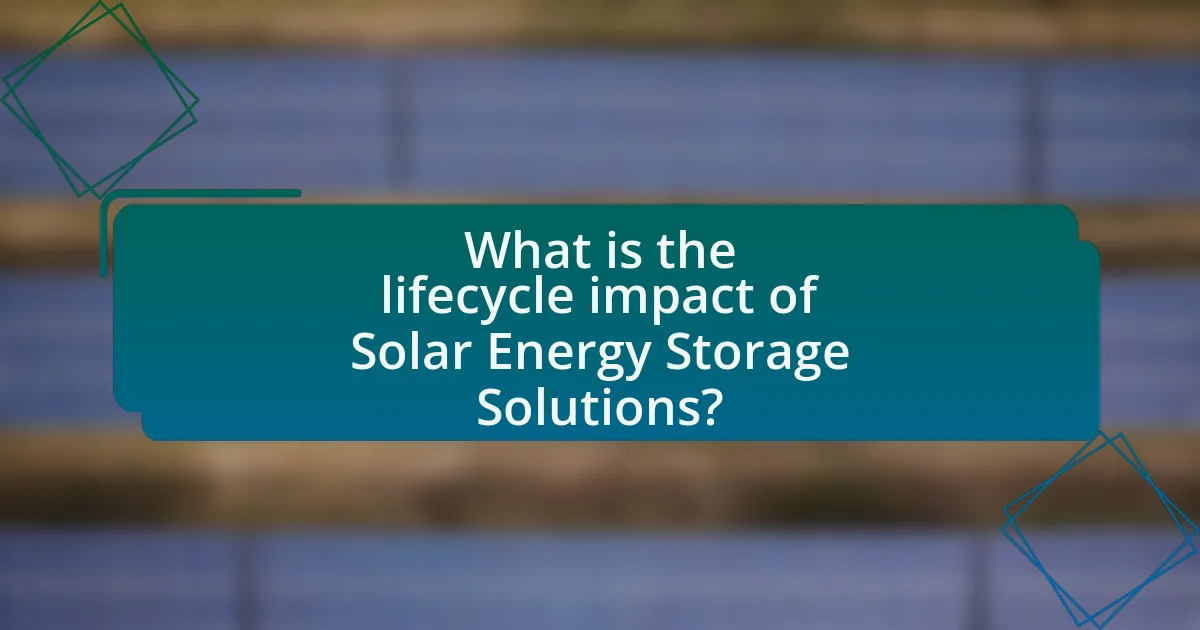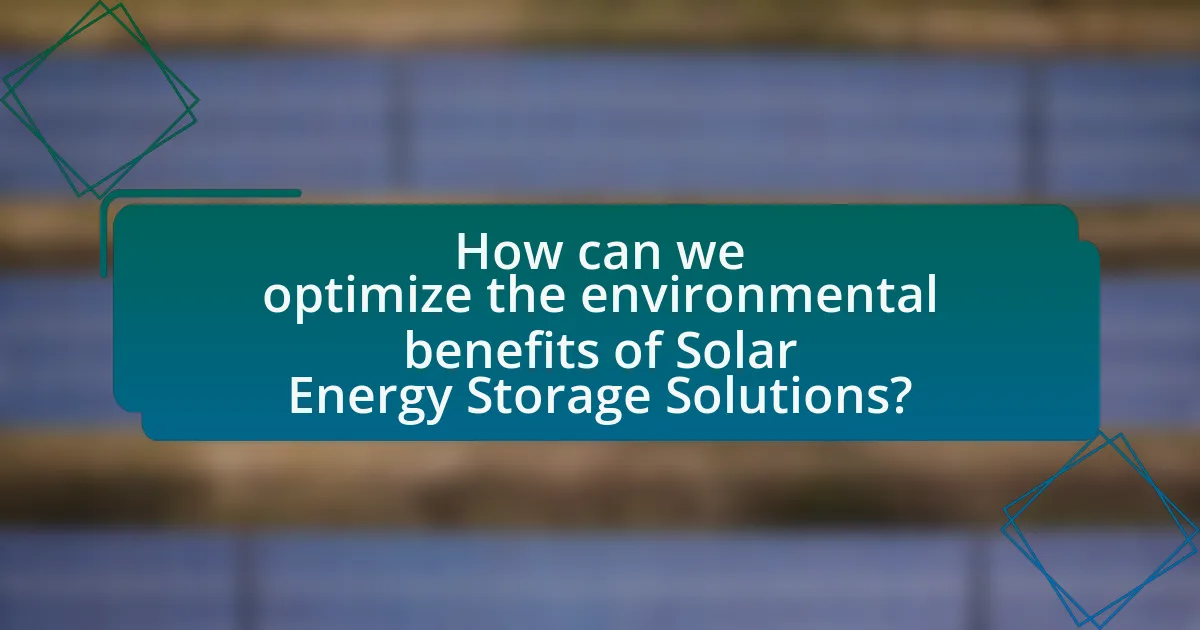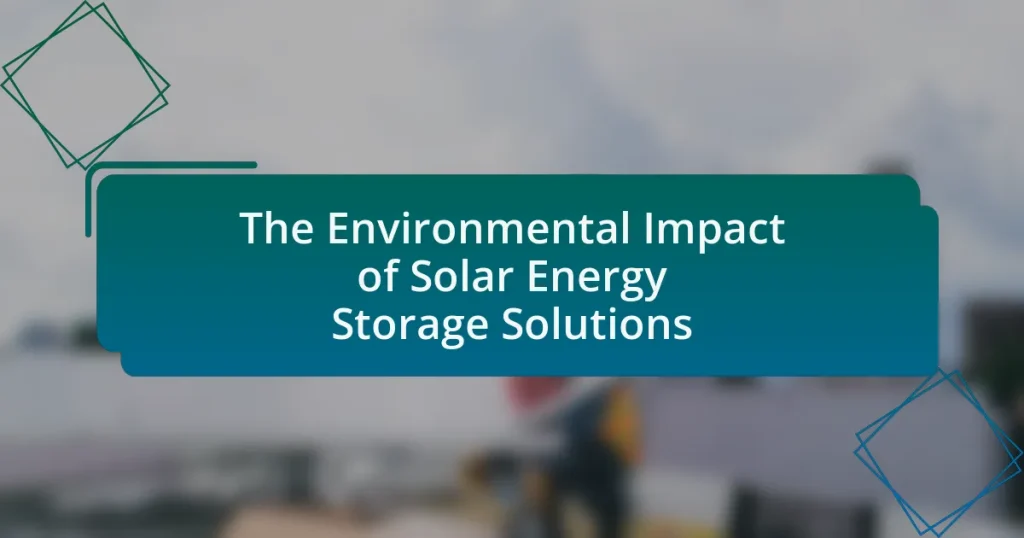Solar energy storage solutions are systems designed to capture and store energy generated from solar panels for later use, utilizing technologies such as lithium-ion batteries, pumped hydro storage, and thermal storage. This article examines the functionality, technologies, and environmental benefits of these storage solutions, highlighting their role in enhancing energy efficiency and reducing carbon emissions. It also addresses the challenges associated with battery production and disposal, the lifecycle impact of these systems, and the implications for land use and local ecosystems. Furthermore, the article discusses best practices for deployment, the importance of recycling, and the influence of policy on promoting sustainable practices in solar energy storage.
What are Solar Energy Storage Solutions?


Solar energy storage solutions are systems that capture and store energy generated from solar panels for later use. These solutions typically include technologies such as batteries, pumped hydro storage, and thermal storage, which allow for the efficient management of energy supply and demand. For instance, lithium-ion batteries are widely used due to their high energy density and decreasing costs, making them a popular choice for residential and commercial solar energy systems. According to the International Energy Agency, the global battery storage market is expected to grow significantly, indicating the increasing reliance on these solutions for energy resilience and sustainability.
How do Solar Energy Storage Solutions function?
Solar energy storage solutions function by capturing and storing excess energy generated from solar panels for later use. These systems typically utilize batteries, such as lithium-ion or lead-acid, to store electricity produced during peak sunlight hours, allowing for energy consumption during periods of low sunlight or high demand. For instance, a solar battery system can store energy generated during the day and release it at night, ensuring a continuous power supply. According to the U.S. Department of Energy, advancements in battery technology have significantly improved the efficiency and lifespan of these storage solutions, making them a viable option for residential and commercial energy management.
What technologies are used in Solar Energy Storage Solutions?
Solar energy storage solutions primarily utilize lithium-ion batteries, lead-acid batteries, flow batteries, and thermal energy storage systems. Lithium-ion batteries are the most common due to their high energy density and efficiency, accounting for a significant share of the market, with a projected growth rate of over 20% annually. Lead-acid batteries, while older technology, are still widely used for their cost-effectiveness in smaller applications. Flow batteries offer scalability and longer discharge times, making them suitable for larger energy storage needs. Thermal energy storage systems, such as molten salt, store heat generated from solar energy for later use, enhancing the overall efficiency of solar power systems. These technologies collectively contribute to the reliability and effectiveness of solar energy storage, facilitating the transition to renewable energy sources.
How do these technologies impact energy efficiency?
Solar energy storage technologies significantly enhance energy efficiency by enabling the capture and utilization of excess solar power generated during peak sunlight hours. These systems, such as lithium-ion batteries, allow for energy to be stored and used later, reducing reliance on fossil fuels and minimizing energy waste. For instance, according to the U.S. Department of Energy, energy storage can increase the overall efficiency of solar energy systems by up to 30% by optimizing energy use and reducing grid congestion. This capability not only maximizes the use of renewable energy but also contributes to a more stable and resilient energy grid.
What are the environmental benefits of Solar Energy Storage Solutions?
Solar energy storage solutions provide significant environmental benefits by enhancing the efficiency and reliability of renewable energy systems. These solutions enable the capture and storage of excess solar energy generated during peak sunlight hours, which can then be utilized during periods of low sunlight or high demand. This capability reduces reliance on fossil fuels, thereby decreasing greenhouse gas emissions and air pollutants associated with traditional energy sources.
For instance, a study by the National Renewable Energy Laboratory found that integrating energy storage with solar power can reduce carbon dioxide emissions by up to 80% compared to conventional energy systems. Additionally, solar energy storage helps to stabilize the grid, minimizing the need for backup power plants that often rely on non-renewable resources. This transition to cleaner energy sources contributes to improved air quality and mitigates climate change impacts, showcasing the vital role of solar energy storage in promoting environmental sustainability.
How do Solar Energy Storage Solutions reduce carbon emissions?
Solar energy storage solutions reduce carbon emissions by enabling the use of renewable energy during peak demand times, thereby decreasing reliance on fossil fuel power plants. When solar energy is stored in batteries or other storage systems, it can be released when sunlight is not available, such as during the night or cloudy days. This capability minimizes the need for carbon-intensive energy sources, which are typically used to meet energy demands during these periods. According to the U.S. Department of Energy, integrating energy storage with solar power can reduce greenhouse gas emissions by up to 80% in certain scenarios, demonstrating the significant impact of these technologies on lowering carbon footprints.
What role do they play in promoting renewable energy usage?
Solar energy storage solutions play a crucial role in promoting renewable energy usage by enabling the efficient capture and utilization of solar power. These systems store excess energy generated during peak sunlight hours, allowing for its use during periods of low sunlight or high demand. According to the U.S. Department of Energy, energy storage can increase the reliability and resilience of solar energy systems, making them more attractive to consumers and businesses. By facilitating a consistent energy supply, solar energy storage solutions help to reduce reliance on fossil fuels and lower greenhouse gas emissions, thereby supporting the transition to a more sustainable energy future.
What challenges do Solar Energy Storage Solutions face?
Solar energy storage solutions face several challenges, including high costs, limited energy density, and environmental concerns related to battery production and disposal. The initial investment for solar storage systems can be substantial, often making them economically unfeasible for many consumers despite decreasing prices over time. Additionally, current battery technologies, such as lithium-ion, have limited energy density, which restricts the amount of energy that can be stored in a compact form. Furthermore, the production of batteries involves the extraction of raw materials, which can lead to environmental degradation, and improper disposal can result in hazardous waste. These factors collectively hinder the widespread adoption and effectiveness of solar energy storage solutions.
What are the environmental concerns associated with battery production?
Battery production raises significant environmental concerns, primarily due to resource extraction, energy consumption, and waste management. The mining of lithium, cobalt, and nickel, essential for battery components, often leads to habitat destruction, water pollution, and soil degradation. For instance, lithium extraction in South America has been linked to water shortages in local communities. Additionally, the manufacturing process is energy-intensive, contributing to greenhouse gas emissions. A study by the International Energy Agency indicates that battery production can generate up to 150 kg of CO2 emissions per kWh of battery capacity. Finally, the disposal of batteries poses a challenge, as improper disposal can lead to toxic chemical leakage, further harming ecosystems.
How does the disposal of storage systems affect the environment?
The disposal of storage systems, particularly lithium-ion batteries used in solar energy solutions, negatively impacts the environment through the release of toxic materials and the potential for groundwater contamination. When these batteries are improperly disposed of, they can leak heavy metals such as lead, cadmium, and nickel into the soil and water systems, posing risks to ecosystems and human health. According to a study published in the journal “Nature Sustainability,” improper disposal of lithium-ion batteries can lead to significant environmental hazards, emphasizing the need for effective recycling and disposal methods to mitigate these risks.
How do Solar Energy Storage Solutions compare to other energy storage methods?
Solar energy storage solutions primarily utilize batteries, such as lithium-ion, to store energy generated from solar panels, which allows for energy use during non-sunny periods. Compared to other energy storage methods, like pumped hydro storage or compressed air energy storage, solar energy storage systems are generally more modular and can be deployed at various scales, from residential to utility-level installations.
For instance, while pumped hydro storage requires significant geographical features and large-scale infrastructure, solar energy storage can be integrated into existing buildings or solar farms with relative ease. Additionally, lithium-ion batteries, commonly used in solar applications, have seen a dramatic decrease in cost—over 80% since 2010—making them increasingly competitive against traditional energy storage methods.
Moreover, solar energy storage solutions contribute to reducing greenhouse gas emissions by enabling the use of renewable energy, whereas fossil fuel-based storage methods do not offer the same environmental benefits. This positions solar energy storage as a more sustainable option in the energy landscape.
What are the future trends in Solar Energy Storage Solutions?
Future trends in solar energy storage solutions include advancements in battery technology, increased integration with smart grids, and the development of sustainable materials. Innovations such as solid-state batteries promise higher energy densities and improved safety compared to traditional lithium-ion batteries. Additionally, the integration of artificial intelligence in energy management systems enhances efficiency by optimizing energy distribution and storage based on real-time data. Research indicates that the global energy storage market is expected to grow significantly, with a projected increase from 10 gigawatts in 2020 to over 200 gigawatts by 2025, highlighting the accelerating demand for effective storage solutions.
What is the lifecycle impact of Solar Energy Storage Solutions?


The lifecycle impact of Solar Energy Storage Solutions includes environmental effects from production, usage, and disposal phases. During production, materials such as lithium, cobalt, and nickel are extracted, which can lead to habitat destruction and pollution. The usage phase generally results in reduced greenhouse gas emissions by enabling the integration of renewable energy sources, thus decreasing reliance on fossil fuels. Finally, the disposal phase poses challenges, as improper recycling can lead to toxic waste, while effective recycling can mitigate environmental harm and recover valuable materials. Studies indicate that while the overall lifecycle impact can be significant, advancements in technology and recycling processes are improving sustainability outcomes.
How does the manufacturing process affect the environment?
The manufacturing process significantly affects the environment through resource extraction, energy consumption, and waste generation. For instance, the production of solar energy storage solutions, such as lithium-ion batteries, involves mining for lithium, cobalt, and nickel, which can lead to habitat destruction and water pollution. Additionally, the manufacturing phase consumes substantial energy, often derived from fossil fuels, contributing to greenhouse gas emissions. A study by the International Energy Agency indicates that battery production can emit up to 150 kg of CO2 per kWh of battery capacity. Furthermore, improper disposal of manufacturing waste can result in soil and water contamination, highlighting the need for sustainable practices in the manufacturing process.
What materials are commonly used in the production of storage systems?
Common materials used in the production of storage systems include lithium, cobalt, nickel, and various types of plastics and metals. Lithium-ion batteries, which are prevalent in energy storage solutions, primarily utilize lithium and cobalt for their electrodes, while nickel is often used to enhance energy density. Additionally, metals like aluminum and copper are employed in the construction of battery casings and electrical connections. Plastics are also utilized for insulation and structural components. These materials are essential for ensuring the efficiency and longevity of storage systems, particularly in solar energy applications.
How do these materials impact environmental sustainability?
The materials used in solar energy storage solutions significantly impact environmental sustainability by influencing resource consumption, waste generation, and energy efficiency. For instance, lithium-ion batteries, commonly used in solar storage, require mining for lithium, cobalt, and nickel, which can lead to habitat destruction and water pollution. According to a study by the International Energy Agency, the demand for lithium is expected to increase by over 40 times by 2040, raising concerns about sustainable mining practices. Additionally, the end-of-life management of these batteries poses challenges, as improper disposal can result in toxic chemical leakage. However, advancements in recycling technologies can mitigate these impacts by recovering valuable materials and reducing the need for new resource extraction, thereby enhancing overall sustainability.
What are the implications of Solar Energy Storage Solutions on land use?
Solar energy storage solutions significantly impact land use by requiring space for the installation of storage facilities, which can lead to land conversion and habitat disruption. The deployment of large-scale battery systems, such as lithium-ion batteries, necessitates substantial land areas, potentially competing with agricultural or natural landscapes. For instance, a study by the National Renewable Energy Laboratory indicates that utility-scale battery storage can occupy up to 10 acres per megawatt of capacity, which can alter land use patterns and affect local ecosystems. Additionally, the infrastructure needed for solar energy storage, including access roads and maintenance areas, further contributes to land use changes, emphasizing the need for careful planning to mitigate negative environmental effects.
How does the installation of storage systems affect local ecosystems?
The installation of storage systems can significantly impact local ecosystems by altering land use, affecting wildlife habitats, and influencing water resources. For instance, the construction of large-scale battery storage facilities often requires substantial land clearing, which can lead to habitat destruction for various species. Additionally, these systems may introduce pollutants into the soil and water systems, potentially harming local flora and fauna. Research indicates that habitat fragmentation caused by such installations can disrupt migration patterns and breeding grounds for wildlife, leading to decreased biodiversity. Furthermore, the extraction of raw materials for battery production, such as lithium, can result in environmental degradation and water depletion in mining areas, further exacerbating the negative effects on local ecosystems.
What measures can be taken to minimize land use impact?
To minimize land use impact, implementing solar energy storage solutions on previously disturbed or degraded land is essential. Utilizing brownfields, rooftops, and parking lots for solar installations reduces the need for new land development. Research indicates that deploying solar panels on existing structures can significantly decrease land consumption, as demonstrated by a study from the National Renewable Energy Laboratory, which found that utilizing rooftops could potentially supply 40% of the nation’s electricity needs without additional land use. Additionally, integrating solar farms with agricultural practices, known as agrivoltaics, allows for dual land use, thereby preserving agricultural land while generating renewable energy.
How can we optimize the environmental benefits of Solar Energy Storage Solutions?


To optimize the environmental benefits of Solar Energy Storage Solutions, it is essential to enhance the efficiency of energy conversion and storage technologies. Improving the efficiency of solar panels and storage systems, such as lithium-ion batteries, can significantly reduce energy loss during conversion and storage processes. For instance, advancements in solar panel technology have led to efficiencies exceeding 22%, while innovations in battery technology, like solid-state batteries, promise higher energy densities and longer lifespans.
Additionally, implementing smart grid technologies can facilitate better energy management, allowing for the integration of renewable energy sources and reducing reliance on fossil fuels. According to the International Energy Agency, optimizing energy storage can lead to a reduction of greenhouse gas emissions by up to 70% in certain scenarios.
Furthermore, recycling and repurposing materials used in solar panels and batteries can minimize waste and environmental impact. Research indicates that recycling lithium-ion batteries can recover up to 95% of the materials, thereby reducing the need for new raw materials and lowering the overall carbon footprint of solar energy systems.
What best practices should be followed in the deployment of Solar Energy Storage Solutions?
The best practices for deploying Solar Energy Storage Solutions include conducting a thorough site assessment, selecting appropriate technology, ensuring proper integration with existing systems, and implementing effective monitoring and maintenance protocols. A comprehensive site assessment identifies optimal locations for solar installations and storage systems, considering factors like sunlight exposure and local regulations. Choosing the right technology, such as lithium-ion or flow batteries, is crucial for efficiency and longevity, as evidenced by the increasing adoption of lithium-ion batteries due to their high energy density and decreasing costs. Proper integration with existing solar systems maximizes energy capture and storage, enhancing overall system performance. Finally, regular monitoring and maintenance ensure that the systems operate at peak efficiency, with studies showing that proactive maintenance can extend the lifespan of storage solutions by up to 30%.
How can recycling programs enhance sustainability?
Recycling programs enhance sustainability by reducing waste and conserving natural resources. These programs facilitate the recovery of materials such as metals, plastics, and paper, which can be reprocessed and reused, thereby decreasing the need for virgin resource extraction. For instance, recycling aluminum saves up to 95% of the energy required to produce new aluminum from raw materials, significantly lowering greenhouse gas emissions. Additionally, recycling diverts waste from landfills, which helps mitigate soil and water contamination. According to the Environmental Protection Agency, recycling and composting prevented the release of approximately 186 million metric tons of carbon dioxide equivalent into the air in 2018, demonstrating the substantial environmental benefits of effective recycling initiatives.
What role does policy play in promoting environmentally friendly practices?
Policy plays a crucial role in promoting environmentally friendly practices by establishing regulations and incentives that encourage sustainable behaviors. For instance, government policies can provide tax credits for renewable energy investments, which directly incentivizes the adoption of solar energy storage solutions. According to the International Renewable Energy Agency, countries with supportive policies, such as feed-in tariffs and renewable portfolio standards, have seen significant increases in renewable energy capacity, demonstrating the effectiveness of policy in driving environmentally friendly practices.
What are the common misconceptions about Solar Energy Storage Solutions?
Common misconceptions about solar energy storage solutions include the belief that they are only effective in sunny climates, that they are prohibitively expensive, and that they require extensive maintenance. In reality, solar energy storage systems can store energy generated from solar panels regardless of weather conditions, making them useful even in less sunny areas. Additionally, the costs of solar storage have decreased significantly, with prices dropping by over 70% since 2010, making them more accessible. Furthermore, modern systems are designed to be low-maintenance, often requiring minimal upkeep compared to traditional energy systems.
How can accurate information improve public perception?
Accurate information can significantly improve public perception by fostering trust and understanding regarding solar energy storage solutions. When the public receives clear, factual data about the environmental benefits and efficiency of these technologies, it reduces misconceptions and fears. For instance, studies have shown that solar energy storage can decrease greenhouse gas emissions by up to 80% compared to fossil fuels, which highlights its positive environmental impact. This concrete evidence helps to build a more favorable view of solar energy solutions, encouraging wider acceptance and adoption.
What are the most frequently asked questions regarding their environmental impact?
The most frequently asked questions regarding the environmental impact of solar energy storage solutions include inquiries about the lifecycle emissions of batteries, the sustainability of raw materials used in battery production, and the potential for recycling or repurposing old batteries. These questions arise because stakeholders are concerned about how the production, use, and disposal of solar energy storage systems affect the environment. For instance, studies indicate that lithium-ion batteries, commonly used in solar storage, can have significant carbon footprints during manufacturing, but they also contribute to reducing greenhouse gas emissions when used in renewable energy systems. Additionally, the sourcing of materials like lithium and cobalt raises concerns about ecological degradation and human rights issues, prompting questions about sustainable mining practices and the feasibility of battery recycling programs.


